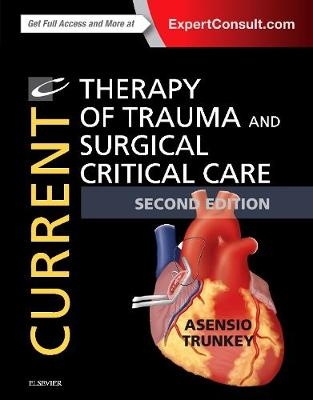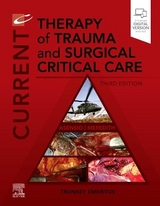
Current Therapy of Trauma and Surgical Critical Care
Elsevier - Health Sciences Division (Verlag)
978-0-323-07980-8 (ISBN)
- Titel erscheint in neuer Auflage
- Artikel merken
"I would recommend it as worthwhile reading and a valuable reference for anyone involved in the care of the trauma patient." Foreword by: Jeffrey T. Sugimoto, Creighton University, June 2015
Stay informed on a wide variety of key topics - more than in any other existing text on trauma and critical care surgery.
Consult this title for a quick overview before you enter the OR or ICU, and use it as a review tool for board certification and recertification.
Review the essential principles of diagnosis and treatment, as well as the specifics of surgical therapy - useful for surgeons across all specialties.
Get up to date with current developments in the use of endovascular stents for thoracic aortic injuries; the diagnosis of peripheral vascular injuries; new interventional imaging techniques and new uses for ultrasound; and new ventilator techniques such as HFJV and APRV.
Make the most of new antibiotics to improve control of surgical infection, learn to use new antifungal agents, and implement innovative therapies to combat both methicillin- and oxacillin-resistant organisms.
Benefit from tremendous recent advances in the field (often as a result of experience gained by military and civilian surgeons), including the development of damage control.
NEW! Expert Consult eBook version included with purchase. This enhanced eBook experience allows you to search all of the text, figures, and references from the book on a variety of devices.
PART I. TRAUMA SYSTEMS
Development of Trauma Systems
Trauma Center Organization and Verification
Injury Severity Scoring: Its Definition and Practical Application
Role of Alcohol and Other Drugs in Trauma
Role of Trauma Prevention in Reducing Interpersonal Violence
Trauma Scoring
Results of the Medical Strategy for Military Trauma in Colombia
PART II. PREHOSPITAL TRAUMA CARE
Influence of Emergency Medical Services on Outcome at Trauma Center
Field Triage in the Military Arena
Field Triage in the Civilian Arena
Prehospital Airway Management: Intubation, Devices, and Controversies
Prehospital Fluid Resuscitation: What Type, How Much, and Controversies
Civilian Hospital Response to Mass Casualty Events
Injuries from Explosives
Prehospital Care of Biologic Agent-Induced Injuries
Wound Ballistics: What Every Trauma Surgeon Should Know
Common Prehospital Complications and Pitfalls in the Trauma Patient
PART III. INITIAL ASSESSMENT AND RESUSCITATION
Airway Management: What Every Trauma Surgeon Should Know, From Intubation to Cricothyroidotomy
Resuscitation Fluids
Resuscitative Thoracotomy
Focused Assessment with Sonography for the Trauma Patient
Role of Radiology in Initial Trauma Evaluation
Interventional Radiology: Diagnostic andTherapeuticRoles
Endpoints of Resuscitation
PART IV. HEAD AND CENTRAL NERVOUS SYSTEM INJURIES
Traumatic Brain Injury: Pathophysiology, Clinical Diagnosis, and Prehospital and Emergency Center Care
Traumatic Brain Injury: Imaging, Operative and Nonoperative Care, and Complications
Spine: Spinal Cord Injury, Blunt and Penetrating, Neurogenic and Spinal Shock
PART V. MAXILLOFACIAL AND OCULAR INJURIES
Maxillofacial Trauma
Trauma to the Eye and Orbit
PART VI. NECK INJURIES
Penetrating Neck Injuries: Diagnosis and Current Management
Blunt Cerebrovascular Injuries
Tracheal, Laryngeal, and Oropharyngeal Injuries
PART VII. THORACIC INJURIES
Pertinent Surgical Anatomy of the Thorax and Mediastinum
Thoracic Wall Injuries: Ribs, Sternal, and Scapular Fractures; Hemothoraces and Pneumothoraces
Diagnostic and Therapeutic Roles of Bronchoscopy and Video-Assisted Thoracoscopy in the Management of Thoracic Trauma
Pulmonary Contusion and Flail Chest
Operative Treatment of Chest Wall Injury
Tracheal and Tracheobronchial Tree Injuries
Operative Management of Pulmonary Injuries: Lung-Sparing and Formal Resections
Complications of Pulmonary and Pleural Injury
Cardiac Injuries
Thoracic Vascular Injury
Open and Endovascular Management of Thoracic Aortic Injuries
Treatment of Esophageal Injury
PART VIII. ABDOMINAL INJURIES
Diaphragmatic Injury
Surgical Anatomy of the Abdomen and Retroperitoneum
Diagnostic Peritoneal Lavage and Laparoscopy in the Evaluation of Abdominal Trauma
Nonoperative Management of Blunt and Penetrating Abdominal Injuries
Gastric Injuries
Small Bowel Injury
Duodenal Injuries
Pancreatic Injuries and Pancreaticoduodenectomy
Liver Injury
Splenic Injuries
Abdominal Vascular Injury
Colon and Rectal Injuries
Genitourinary Tract Injuries
Gynecologic Injuries: Trauma to Gravid and Nongravid Uterus and Female Genitalia
Multidisciplinary Management of Pelvic Fractures: Operative and Nonoperative Management
PART IX. SPECIAL ISSUES IN MAJOR TORSO TRAUMA
Current Concepts in the Diagnosis and Management of Hemorrhagic Shock
The Syndrome of Exsanguination: Reliable Models to Indicate Damage Control
Damage Control Resuscitation: An Evidence-Based Report
Surgical Techniques for Thoracic, Abdominal, Pelvic, and Extremity Damage Control
Abdominal Compartment Syndrome, Damage Control, and the Open Abdomen
Torso Trauma on the Modern Battlefield
PART X. PERIPHERAL VASCULAR INJURY
Vascular Anatomy of the Extremities
Diagnosis of Vascular Trauma
Penetrating Carotid Artery: Uncommon Complex and Lethal Injuries
Subclavian Vessel Injuries: Difficult Anatomy and Difficult Territory
Operative Exposure and Management of Axillary Vessel Injuries
Brachial Vessel Injuries: High Morbidity and Low Mortality Injuries
Iliac Vessel Injuries: Difficult Injuries and Difficult Management Problems
Femoral Vessel Injuries: High Mortality and Low Morbidity Injuries
Popliteal Vessel Injuries: Complex Anatomy and High Amputation Rates
Temporary Vascular Shunts
PART XI. MUSCULOSKELETAL AND PERIPHERAL CENTRAL NERVOUS SYSTEM INJURIES
Upper Extremity Fractures: Orthopaedic Management
Lower Extremity and Degloving Injury
Cervical, Thoracic, and Lumbar Fractures
Pelvic Fractures
Wrist and Hand Fractures: Orthopaedic Management of Current Therapy of Trauma and Surgical Critical
Care
Scapulothoracic Dissociation and Degloving Injuries of the Extremities
Extremity Replantation: Indications and Timing
Special Techniques for the Management of Complex Musculoskeletal Injuries: The Roles of Fasciocutaneous and Myocutaneous Flaps
PART XII. SPECIAL ISSUES AND SITUATIONS IN TRAUMA MANAGEMENT
Airway Management: What Every Surgeon Should Know about the Traumatic Airway (The Anesthesiologist's Perspective)
Pediatric Trauma
Trauma in Pregnancy
Trauma in our "Elders"
Burns
Soft Tissue Infections
Common Errors in Trauma Care
Combat Trauma Care: Lessons Learned from a Decade of War
PART XIII. CRITICAL CARE I: MANAGEMENT OF ORGAN FAILURES AND TECHNIQUES FOR SUPPORT
Cardiac Hemodynamics: The Pulmonary Artery Catheter and the Meaning of Its Readings
Oxygen Transport
Pharmacologic Support of Cardiac Failure
Diagnosis and Management of Cardiac Dysrhythmias
Fundamentals of Mechanical Ventilation
Advanced Techniques in Mechanical Ventilation
Management of Renal Failure: Renal Replacement Therapy and Dialysis
Management of Coagulation Disorders in the Surgical Intensive Care Unit
Management of Endocrine Disorders in the Surgical Intensive Care Unit
Transfusion: Management of Blood and Blood Products in Trauma
PART XIV: CRITICAL CARE II: SPECIAL ISSUES AND TREATMENTS
Acute Respiratory Distress Syndrome
Systemic Inflammatory Response Syndrome and Multiple- Organ Dysfunction Syndrome: Definition, Diagnosis, and Management
Sepsis, Septic Shock, and Its Treatment
Immunology of Trauma
Overview of Infectious Diseases in Trauma Patients
Nosocomial Pneumonia
Antibiotic Use in the Intensive Care Unit: The Old and the New
Fungal Colonization and Infection During Critical Illness
Preoperative and Postoperative Nutritional Support: Strategies for Enteral and Parenteral Therapies
Venous Thromboembolism: Diagnosis and Treatment
Hypothermia and Trauma
Surgical Procedures in the Surgical Intensive Care Unit
Anesthesia in the Critical Care Unit and Pain Management
Diagnostic Management of Brain Death in the Intensive Care
Unit and Organ Donation
PART XV: REHABILITATION AND QUALITY OF LIFE AFTER TRAUMA AND OTHER ISSUES
Palliative Care in the Trauma Intensive Care Unit
Trauma Rehabilitation
Trauma Outcomes
| Erscheint lt. Verlag | 1.7.2015 |
|---|---|
| Verlagsort | Philadelphia |
| Sprache | englisch |
| Maße | 216 x 276 mm |
| Gewicht | 2490 g |
| Themenwelt | Medizin / Pharmazie ► Medizinische Fachgebiete ► Chirurgie |
| Medizin / Pharmazie ► Medizinische Fachgebiete ► Notfallmedizin | |
| ISBN-10 | 0-323-07980-6 / 0323079806 |
| ISBN-13 | 978-0-323-07980-8 / 9780323079808 |
| Zustand | Neuware |
| Haben Sie eine Frage zum Produkt? |
aus dem Bereich



